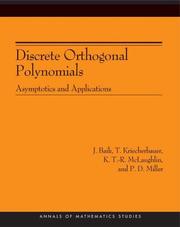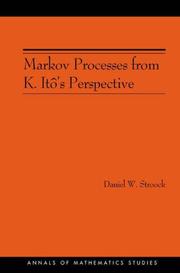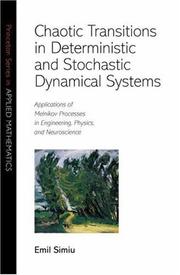| Listing 1 - 4 of 4 |
Sort by
|

ISBN: 9780691096278 0691096279 9786612087592 1400825105 1282087592 1400814243 9781400814244 9781400825103 Year: 2009 Publisher: Princeton, NJ
Abstract | Keywords | Export | Availability | Bookmark
 Loading...
Loading...Choose an application
- Reference Manager
- EndNote
- RefWorks (Direct export to RefWorks)
The modeling of stochastic dependence is fundamental for understanding random systems evolving in time. When measured through linear correlation, many of these systems exhibit a slow correlation decay--a phenomenon often referred to as long-memory or long-range dependence. An example of this is the absolute returns of equity data in finance. Selfsimilar stochastic processes (particularly fractional Brownian motion) have long been postulated as a means to model this behavior, and the concept of selfsimilarity for a stochastic process is now proving to be extraordinarily useful. Selfsimilarity translates into the equality in distribution between the process under a linear time change and the same process properly scaled in space, a simple scaling property that yields a remarkably rich theory with far-flung applications. After a short historical overview, this book describes the current state of knowledge about selfsimilar processes and their applications. Concepts, definitions and basic properties are emphasized, giving the reader a road map of the realm of selfsimilarity that allows for further exploration. Such topics as noncentral limit theory, long-range dependence, and operator selfsimilarity are covered alongside statistical estimation, simulation, sample path properties, and stochastic differential equations driven by selfsimilar processes. Numerous references point the reader to current applications. Though the text uses the mathematical language of the theory of stochastic processes, researchers and end-users from such diverse fields as mathematics, physics, biology, telecommunications, finance, econometrics, and environmental science will find it an ideal entry point for studying the already extensive theory and applications of selfsimilarity.
Self-similar processes. --- Distribution (Probability theory) --- Processus autosimilaires --- Distribution (Théorie des probabilités) --- 519.218 --- Self-similar processes --- 519.24 --- Distribution functions --- Frequency distribution --- Characteristic functions --- Probabilities --- Selfsimilar processes --- Stochastic processes --- Special stochastic processes --- 519.218 Special stochastic processes --- Distribution (Théorie des probabilités) --- Almost surely. --- Approximation. --- Asymptotic analysis. --- Autocorrelation. --- Autoregressive conditional heteroskedasticity. --- Autoregressive–moving-average model. --- Availability. --- Benoit Mandelbrot. --- Brownian motion. --- Central limit theorem. --- Change of variables. --- Computational problem. --- Confidence interval. --- Correlogram. --- Covariance matrix. --- Data analysis. --- Data set. --- Determination. --- Fixed point (mathematics). --- Foreign exchange market. --- Fractional Brownian motion. --- Function (mathematics). --- Gaussian process. --- Heavy-tailed distribution. --- Heuristic method. --- High frequency. --- Inference. --- Infimum and supremum. --- Instance (computer science). --- Internet traffic. --- Joint probability distribution. --- Likelihood function. --- Limit (mathematics). --- Linear regression. --- Log–log plot. --- Marginal distribution. --- Mathematica. --- Mathematical finance. --- Mathematics. --- Methodology. --- Mixture model. --- Model selection. --- Normal distribution. --- Parametric model. --- Power law. --- Probability theory. --- Publication. --- Random variable. --- Regime. --- Renormalization. --- Result. --- Riemann sum. --- Self-similar process. --- Self-similarity. --- Simulation. --- Smoothness. --- Spectral density. --- Square root. --- Stable distribution. --- Stable process. --- Stationary process. --- Stationary sequence. --- Statistical inference. --- Statistical physics. --- Statistics. --- Stochastic calculus. --- Stochastic process. --- Technology. --- Telecommunication. --- Textbook. --- Theorem. --- Time series. --- Variance. --- Wavelet. --- Website.

ISBN: 9780691127330 0691127336 9780691127347 0691127344 1400837138 1299224121 9781400837137 9781299224124 Year: 2007 Volume: 164 Publisher: Princeton, NJ
Abstract | Keywords | Export | Availability | Bookmark
 Loading...
Loading...Choose an application
- Reference Manager
- EndNote
- RefWorks (Direct export to RefWorks)
This book describes the theory and applications of discrete orthogonal polynomials--polynomials that are orthogonal on a finite set. Unlike other books, Discrete Orthogonal Polynomials addresses completely general weight functions and presents a new methodology for handling the discrete weights case. J. Baik, T. Kriecherbauer, K. T.-R. McLaughlin & P. D. Miller focus on asymptotic aspects of general, nonclassical discrete orthogonal polynomials and set out applications of current interest. Topics covered include the probability theory of discrete orthogonal polynomial ensembles and the continuum limit of the Toda lattice. The primary concern throughout is the asymptotic behavior of discrete orthogonal polynomials for general, nonclassical measures, in the joint limit where the degree increases as some fraction of the total number of points of collocation. The book formulates the orthogonality conditions defining these polynomials as a kind of Riemann-Hilbert problem and then generalizes the steepest descent method for such a problem to carry out the necessary asymptotic analysis.
Orthogonal polynomials --- Asymptotic theory --- Orthogonal polynomials -- Asymptotic theory. --- Polynomials. --- Civil & Environmental Engineering --- Engineering & Applied Sciences --- Operations Research --- Asymptotic theory. --- Asymptotic theory of orthogonal polynomials --- Algebra --- Airy function. --- Analytic continuation. --- Analytic function. --- Ansatz. --- Approximation error. --- Approximation theory. --- Asymptote. --- Asymptotic analysis. --- Asymptotic expansion. --- Asymptotic formula. --- Beta function. --- Boundary value problem. --- Calculation. --- Cauchy's integral formula. --- Cauchy–Riemann equations. --- Change of variables. --- Complex number. --- Complex plane. --- Correlation function. --- Degeneracy (mathematics). --- Determinant. --- Diagram (category theory). --- Discrete measure. --- Distribution function. --- Eigenvalues and eigenvectors. --- Equation. --- Estimation. --- Existential quantification. --- Explicit formulae (L-function). --- Factorization. --- Fredholm determinant. --- Functional derivative. --- Gamma function. --- Gradient descent. --- Harmonic analysis. --- Hermitian matrix. --- Homotopy. --- Hypergeometric function. --- I0. --- Identity matrix. --- Inequality (mathematics). --- Integrable system. --- Invariant measure. --- Inverse scattering transform. --- Invertible matrix. --- Jacobi matrix. --- Joint probability distribution. --- Lagrange multiplier. --- Lax equivalence theorem. --- Limit (mathematics). --- Linear programming. --- Lipschitz continuity. --- Matrix function. --- Maxima and minima. --- Monic polynomial. --- Monotonic function. --- Morera's theorem. --- Neumann series. --- Number line. --- Orthogonal polynomials. --- Orthogonality. --- Orthogonalization. --- Parameter. --- Parametrix. --- Pauli matrices. --- Pointwise convergence. --- Pointwise. --- Polynomial. --- Potential theory. --- Probability distribution. --- Probability measure. --- Probability theory. --- Probability. --- Proportionality (mathematics). --- Quantity. --- Random matrix. --- Random variable. --- Rate of convergence. --- Rectangle. --- Rhombus. --- Riemann surface. --- Special case. --- Spectral theory. --- Statistic. --- Subset. --- Theorem. --- Toda lattice. --- Trace (linear algebra). --- Trace class. --- Transition point. --- Triangular matrix. --- Trigonometric functions. --- Uniform continuity. --- Unit vector. --- Upper and lower bounds. --- Upper half-plane. --- Variational inequality. --- Weak solution. --- Weight function. --- Wishart distribution. --- Orthogonal polynomials - Asymptotic theory

ISBN: 0691115427 1400835577 0691115435 1322063230 9781400835577 9781322063232 9780691115436 9870691115427 9780691115429 Year: 2003 Publisher: Princeton, NJ
Abstract | Keywords | Export | Availability | Bookmark
 Loading...
Loading...Choose an application
- Reference Manager
- EndNote
- RefWorks (Direct export to RefWorks)
Kiyosi Itô's greatest contribution to probability theory may be his introduction of stochastic differential equations to explain the Kolmogorov-Feller theory of Markov processes. Starting with the geometric ideas that guided him, this book gives an account of Itô's program. The modern theory of Markov processes was initiated by A. N. Kolmogorov. However, Kolmogorov's approach was too analytic to reveal the probabilistic foundations on which it rests. In particular, it hides the central role played by the simplest Markov processes: those with independent, identically distributed increments. To remedy this defect, Itô interpreted Kolmogorov's famous forward equation as an equation that describes the integral curve of a vector field on the space of probability measures. Thus, in order to show how Itô's thinking leads to his theory of stochastic integral equations, Stroock begins with an account of integral curves on the space of probability measures and then arrives at stochastic integral equations when he moves to a pathspace setting. In the first half of the book, everything is done in the context of general independent increment processes and without explicit use of Itô's stochastic integral calculus. In the second half, the author provides a systematic development of Itô's theory of stochastic integration: first for Brownian motion and then for continuous martingales. The final chapter presents Stratonovich's variation on Itô's theme and ends with an application to the characterization of the paths on which a diffusion is supported. The book should be accessible to readers who have mastered the essentials of modern probability theory and should provide such readers with a reasonably thorough introduction to continuous-time, stochastic processes.
Markov processes. --- Stochastic difference equations. --- Itō, Kiyosi, --- Analysis, Markov --- Chains, Markov --- Markoff processes --- Markov analysis --- Markov chains --- Markov models --- Models, Markov --- Processes, Markov --- Itō, K. --- Ito, Kiesi, --- Itō, Kiyoshi, --- 伊藤淸, --- 伊藤清, --- Itō, Kiyosi, --- Itō, Kiyosi, 1915-2008. --- Stochastic difference equations --- Difference equations --- Stochastic processes --- Abelian group. --- Addition. --- Analytic function. --- Approximation. --- Bernhard Riemann. --- Bounded variation. --- Brownian motion. --- Central limit theorem. --- Change of variables. --- Coefficient. --- Complete metric space. --- Compound Poisson process. --- Continuous function (set theory). --- Continuous function. --- Convergence of measures. --- Convex function. --- Coordinate system. --- Corollary. --- David Hilbert. --- Decomposition theorem. --- Degeneracy (mathematics). --- Derivative. --- Diffeomorphism. --- Differentiable function. --- Differentiable manifold. --- Differential equation. --- Differential geometry. --- Dimension. --- Directional derivative. --- Doob–Meyer decomposition theorem. --- Duality principle. --- Elliptic operator. --- Equation. --- Euclidean space. --- Existential quantification. --- Fourier transform. --- Function space. --- Functional analysis. --- Fundamental solution. --- Fundamental theorem of calculus. --- Homeomorphism. --- Hölder's inequality. --- Initial condition. --- Integral curve. --- Integral equation. --- Integration by parts. --- Invariant measure. --- Itô calculus. --- Itô's lemma. --- Joint probability distribution. --- Lebesgue measure. --- Linear interpolation. --- Lipschitz continuity. --- Local martingale. --- Logarithm. --- Markov chain. --- Markov process. --- Markov property. --- Martingale (probability theory). --- Normal distribution. --- Ordinary differential equation. --- Ornstein–Uhlenbeck process. --- Polynomial. --- Principal part. --- Probability measure. --- Probability space. --- Probability theory. --- Pseudo-differential operator. --- Radon–Nikodym theorem. --- Representation theorem. --- Riemann integral. --- Riemann sum. --- Riemann–Stieltjes integral. --- Scientific notation. --- Semimartingale. --- Sign (mathematics). --- Special case. --- Spectral sequence. --- Spectral theory. --- State space. --- State-space representation. --- Step function. --- Stochastic calculus. --- Stochastic. --- Stratonovich integral. --- Submanifold. --- Support (mathematics). --- Tangent space. --- Tangent vector. --- Taylor's theorem. --- Theorem. --- Theory. --- Topological space. --- Topology. --- Translational symmetry. --- Uniform convergence. --- Variable (mathematics). --- Vector field. --- Weak convergence (Hilbert space). --- Weak topology.

ISBN: 0691050945 1400832500 9781400832507 9780691144344 0691144346 9780691144344 9780691050942 Year: 2002 Publisher: Princeton, New Jersey
Abstract | Keywords | Export | Availability | Bookmark
 Loading...
Loading...Choose an application
- Reference Manager
- EndNote
- RefWorks (Direct export to RefWorks)
The classical Melnikov method provides information on the behavior of deterministic planar systems that may exhibit transitions, i.e. escapes from and captures into preferred regions of phase space. This book develops a unified treatment of deterministic and stochastic systems that extends the applicability of the Melnikov method to physically realizable stochastic planar systems with additive, state-dependent, white, colored, or dichotomous noise. The extended Melnikov method yields the novel result that motions with transitions are chaotic regardless of whether the excitation is deterministic or stochastic. It explains the role in the occurrence of transitions of the characteristics of the system and its deterministic or stochastic excitation, and is a powerful modeling and identification tool. The book is designed primarily for readers interested in applications. The level of preparation required corresponds to the equivalent of a first-year graduate course in applied mathematics. No previous exposure to dynamical systems theory or the theory of stochastic processes is required. The theoretical prerequisites and developments are presented in the first part of the book. The second part of the book is devoted to applications, ranging from physics to mechanical engineering, naval architecture, oceanography, nonlinear control, stochastic resonance, and neurophysiology.
Differentiable dynamical systems. --- Chaotic behavior in systems. --- Stochastic systems. --- Systems, Stochastic --- Stochastic processes --- System analysis --- Chaos in systems --- Chaos theory --- Chaotic motion in systems --- Differentiable dynamical systems --- Dynamics --- Nonlinear theories --- System theory --- Differential dynamical systems --- Dynamical systems, Differentiable --- Dynamics, Differentiable --- Differential equations --- Global analysis (Mathematics) --- Topological dynamics --- Affine transformation. --- Amplitude. --- Arbitrarily large. --- Attractor. --- Autocovariance. --- Big O notation. --- Central limit theorem. --- Change of variables. --- Chaos theory. --- Coefficient of variation. --- Compound Probability. --- Computational problem. --- Control theory. --- Convolution. --- Coriolis force. --- Correlation coefficient. --- Covariance function. --- Cross-covariance. --- Cumulative distribution function. --- Cutoff frequency. --- Deformation (mechanics). --- Derivative. --- Deterministic system. --- Diagram (category theory). --- Diffeomorphism. --- Differential equation. --- Dirac delta function. --- Discriminant. --- Dissipation. --- Dissipative system. --- Dynamical system. --- Eigenvalues and eigenvectors. --- Equations of motion. --- Even and odd functions. --- Excitation (magnetic). --- Exponential decay. --- Extreme value theory. --- Flow velocity. --- Fluid dynamics. --- Forcing (recursion theory). --- Fourier series. --- Fourier transform. --- Fractal dimension. --- Frequency domain. --- Gaussian noise. --- Gaussian process. --- Harmonic analysis. --- Harmonic function. --- Heteroclinic orbit. --- Homeomorphism. --- Homoclinic orbit. --- Hyperbolic point. --- Inference. --- Initial condition. --- Instability. --- Integrable system. --- Invariant manifold. --- Iteration. --- Joint probability distribution. --- LTI system theory. --- Limit cycle. --- Linear differential equation. --- Logistic map. --- Marginal distribution. --- Moduli (physics). --- Multiplicative noise. --- Noise (electronics). --- Nonlinear control. --- Nonlinear system. --- Ornstein–Uhlenbeck process. --- Oscillation. --- Parameter space. --- Parameter. --- Partial differential equation. --- Perturbation function. --- Phase plane. --- Phase space. --- Poisson distribution. --- Probability density function. --- Probability distribution. --- Probability theory. --- Probability. --- Production–possibility frontier. --- Relative velocity. --- Scale factor. --- Shear stress. --- Spectral density. --- Spectral gap. --- Standard deviation. --- Stochastic process. --- Stochastic resonance. --- Stochastic. --- Stream function. --- Surface stress. --- Symbolic dynamics. --- The Signal and the Noise. --- Topological conjugacy. --- Transfer function. --- Variance. --- Vorticity.
| Listing 1 - 4 of 4 |
Sort by
|

 Search
Search Feedback
Feedback About UniCat
About UniCat  Help
Help News
News